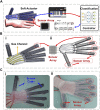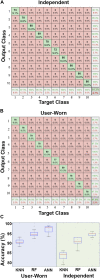Feeling the beat: a smart hand exoskeleton for learning to play musical instruments
- PMID: 37457389
- PMCID: PMC10338871
- DOI: 10.3389/frobt.2023.1212768
Feeling the beat: a smart hand exoskeleton for learning to play musical instruments
Abstract
Individuals who have suffered neurotrauma like a stroke or brachial plexus injury often experience reduced limb functionality. Soft robotic exoskeletons have been successful in assisting rehabilitative treatment and improving activities of daily life but restoring dexterity for tasks such as playing musical instruments has proven challenging. This research presents a soft robotic hand exoskeleton coupled with machine learning algorithms to aid in relearning how to play the piano by 'feeling' the difference between correct and incorrect versions of the same song. The exoskeleton features piezoresistive sensor arrays with 16 taxels integrated into each fingertip. The hand exoskeleton was created as a single unit, with polyvinyl acid (PVA) used as a stent and later dissolved to construct the internal pressure chambers for the five individually actuated digits. Ten variations of a song were produced, one that was correct and nine containing rhythmic errors. To classify these song variations, Random Forest (RF), K-Nearest Neighbor (KNN), and Artificial Neural Network (ANN) algorithms were trained with data from the 80 taxels combined from the tactile sensors in the fingertips. Feeling the differences between correct and incorrect versions of the song was done with the exoskeleton independently and while the exoskeleton was worn by a person. Results demonstrated that the ANN algorithm had the highest classification accuracy of 97.13% ± 2.00% with the human subject and 94.60% ± 1.26% without. These findings highlight the potential of the smart exoskeleton to aid disabled individuals in relearning dexterous tasks like playing musical instruments.
Keywords: 3D print; artificial intelligence; exoskeleton; hand; sensor array; soft robot.
Copyright © 2023 Lin, Paul, Abd, Jones, Dieujuste, Chim and Engeberg.
Conflict of interest statement
The authors declare that the research was conducted in the absence of any commercial or financial relationships that could be construed as a potential conflict of interest.
Figures






References
-
- Al-Fahaam H., Davis S., Nefti-Meziani S. (2016). “Wrist rehabilitation exoskeleton robot based on pneumatic soft actuators,” in 2016 international conference for students on applied engineering (ICSAE) (IEEE; ), 491–496.
-
- Ambrosini E., Ferrante S., Rossini M., Molteni F., Gföhler M., Reichenfelser W., et al. (2014). Functional and usability assessment of a robotic exoskeleton arm to support activities of daily life. Robotica 32, 1213–1224. 10.1017/s0263574714001891 - DOI
-
- Andrikopoulos G., Nikolakopoulos G., Manesis S. (2015). “Motion control of a novel robotic wrist exoskeleton via pneumatic muscle actuators,” in 2015 IEEE 20th conference on emerging technologies and factory automation (ETFA) (IEEE; ), 1–8.
Grants and funding
LinkOut - more resources
Full Text Sources
Miscellaneous

